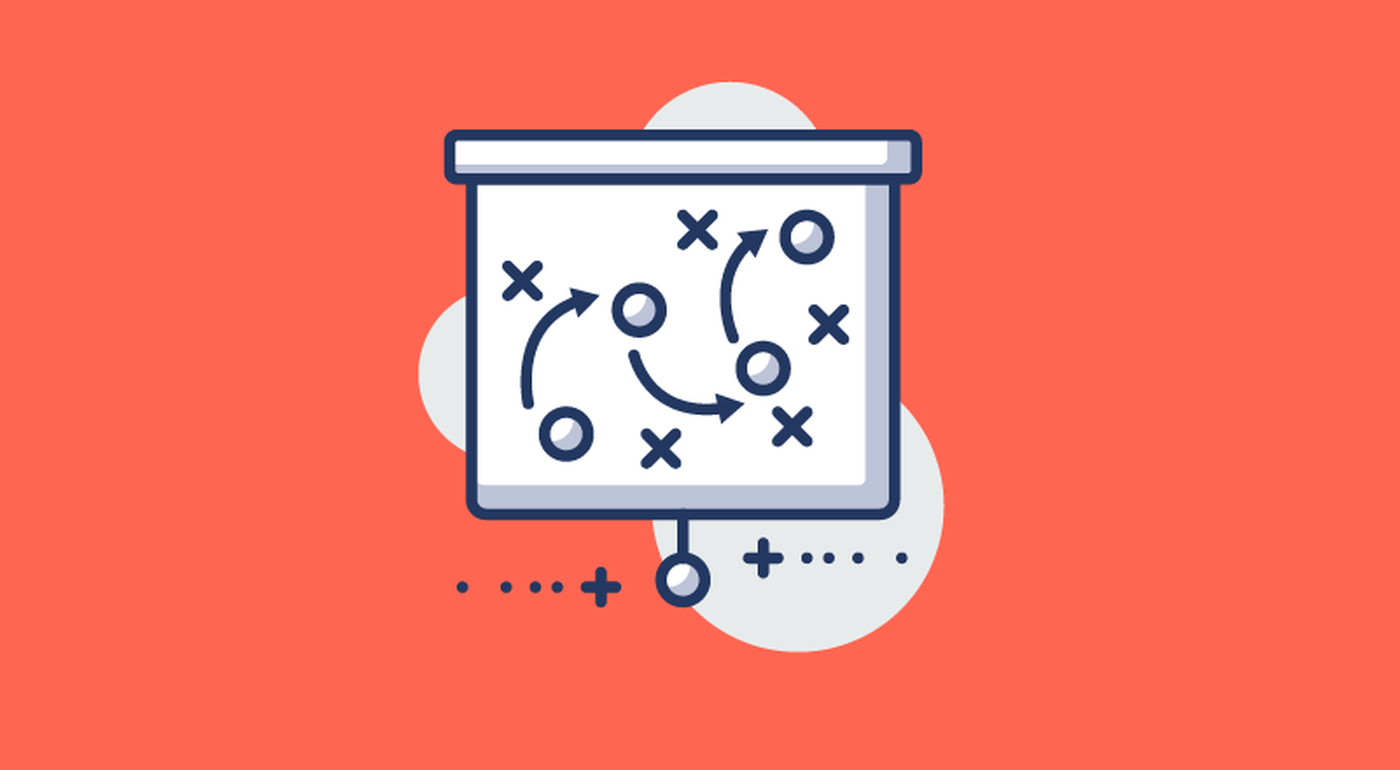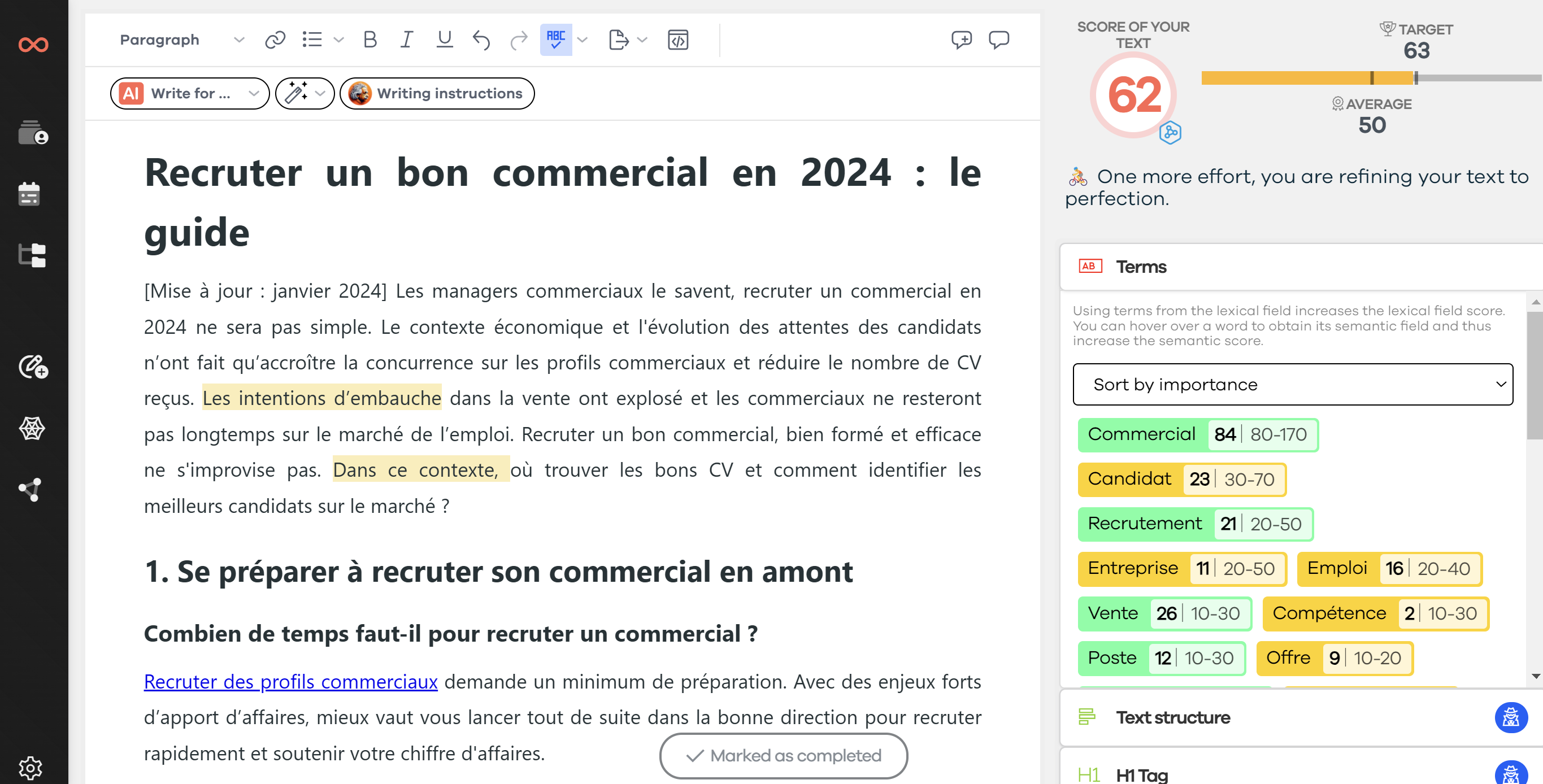Although you should pay attention to your entire copywriting, some parts are particularly important. These hot zones of web writing help meet the needs of your reader and improve your SEO! Discover the 11 elements of content not to be neglected and how to optimize them accordingly.
🚀 Quick read: the 11 hot zones of web writing
- Title
- Introduction
- Subtitles
- Conclusion
- Bold words
- Lists
- Internal links
- Image attributes
- Meta title
- Meta description
- URL
👨🏫 Definition of a hot zone in SEO
A hot zone in web writing refers to the strategic locations that you absolutely must optimize for SEO. These elements are defined based on their influence on the reading habits of internet users, as well as the functioning of search engine algorithms.
You can easily compare this process to the one used in supermarkets to attract customers. Posters display the best deals of the moment, while end caps contain the featured products. Adapting your web pages to this same principle is essential to make your audience want to read your content, allow them to quickly find what they are looking for, and offer them the best solutions to meet their needs.
To optimize the SEO of hot zones on web pages, the copywriter must:
- make the reader want to continue reading,
- place your keywords (main and secondary),
- deepen the lexical field and semantics.
👓 Understanding reading habits to optimize hot zones in web writing
When you understand the reading habits of internet users, the key locations to optimize in web writing become quite obvious. Of course, there are also Google algorithms that influence the importance of certain parts of your content.
Here is a summary of what you absolutely need to know to optimize your web pages optimally.
- Average reading time of a web page: according to the latest studies conducted in the United States, a visitor spends an average of 54 seconds on a website. It is also estimated that a reader spends only 8 seconds per page.
- Internet users' habits in digital reading: eye tracking of internet users has shown a general tendency to read in an "F" pattern. This demonstrates a constant lack of interest during the user's journey on a web page.
- Behavior of Googlers: The same approach is observed on Google's SERP: results quickly scanned in an "F" pattern. Moreover, after two unsuccessful clicks, they tend to reformulate their query. Finally, less than 10% go beyond the first page.
- Click-through rate: the analysis by Backlinko of 5 million Google searches shows the following facts: 75.1% of clicks on the first three displayed results, the most effective titles contain a question and are between 15 and 40 characters, pages with a unique meta description have a 5.6% higher CTR than those without one.
- Other SEO factors: internal linking, URL, content highlighting, first 100 words, HTML structure, description of visual content, are all elements to consider when filling hot zones in SEO web writing.
Note that the click-through rate is certainly an important element for Google. Indeed, their goal is to offer users relevant results based on their search intent. Therefore, if a displayed result is not visited enough, it is likely to be downgraded.
Now that you are aware of these facts, you will better understand why some parts of your content must be particularly well-crafted for the user experience (UX) and organic search ranking.
🥇 The title of your text (H1 tag)
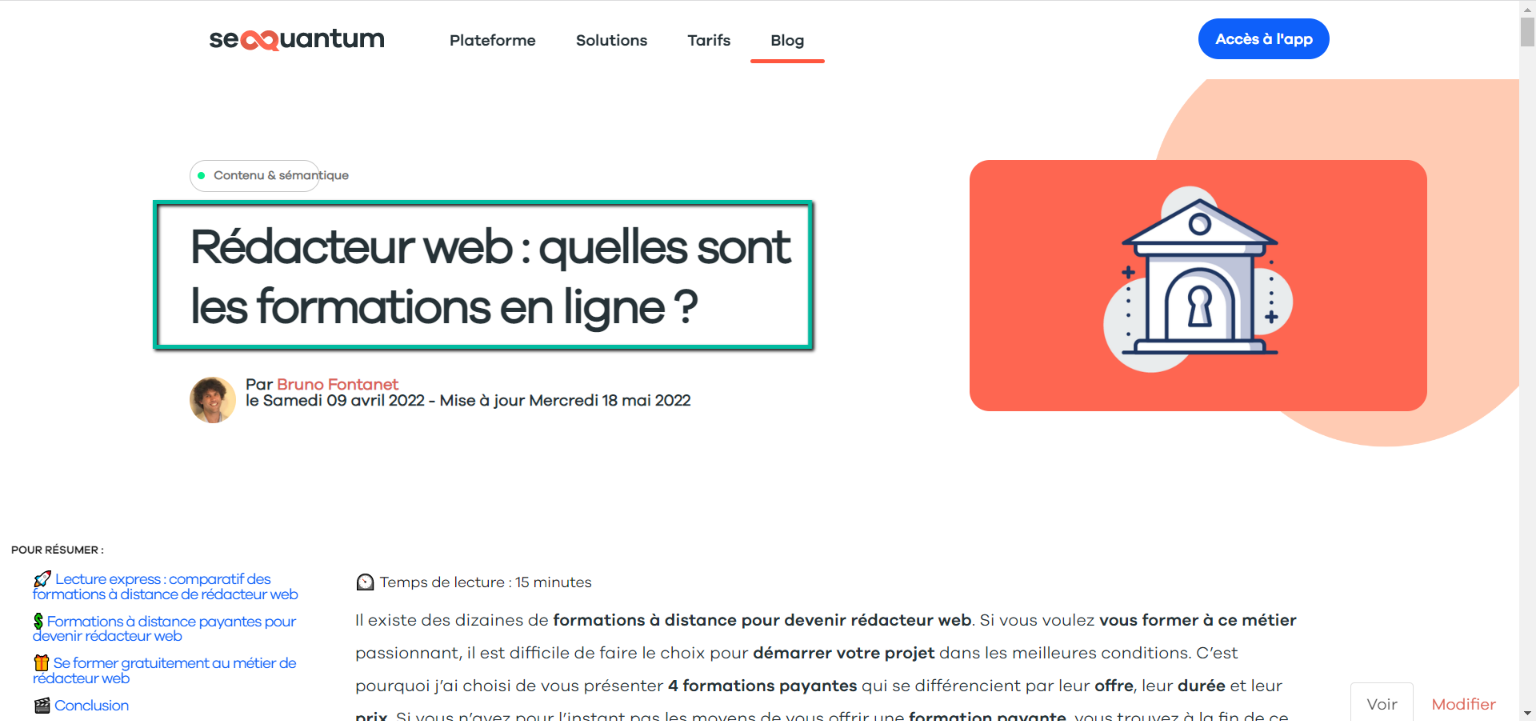
This is the first piece of information your visitor gets when they arrive on your web page. The title of your article should be impactful and make the reader want to read it. In copywriting, the techniques used to optimize your title are as follows:
- precision,
- emotion,
- problem,
- solution.
The title is a promise you make to your reader. This key information will prompt them to read the page. Moreover, for SEO, you must include your main keyword naturally, preferably at the beginning of the title, while remaining representative of the content offered on your page.
🥁 The introduction (or lead)
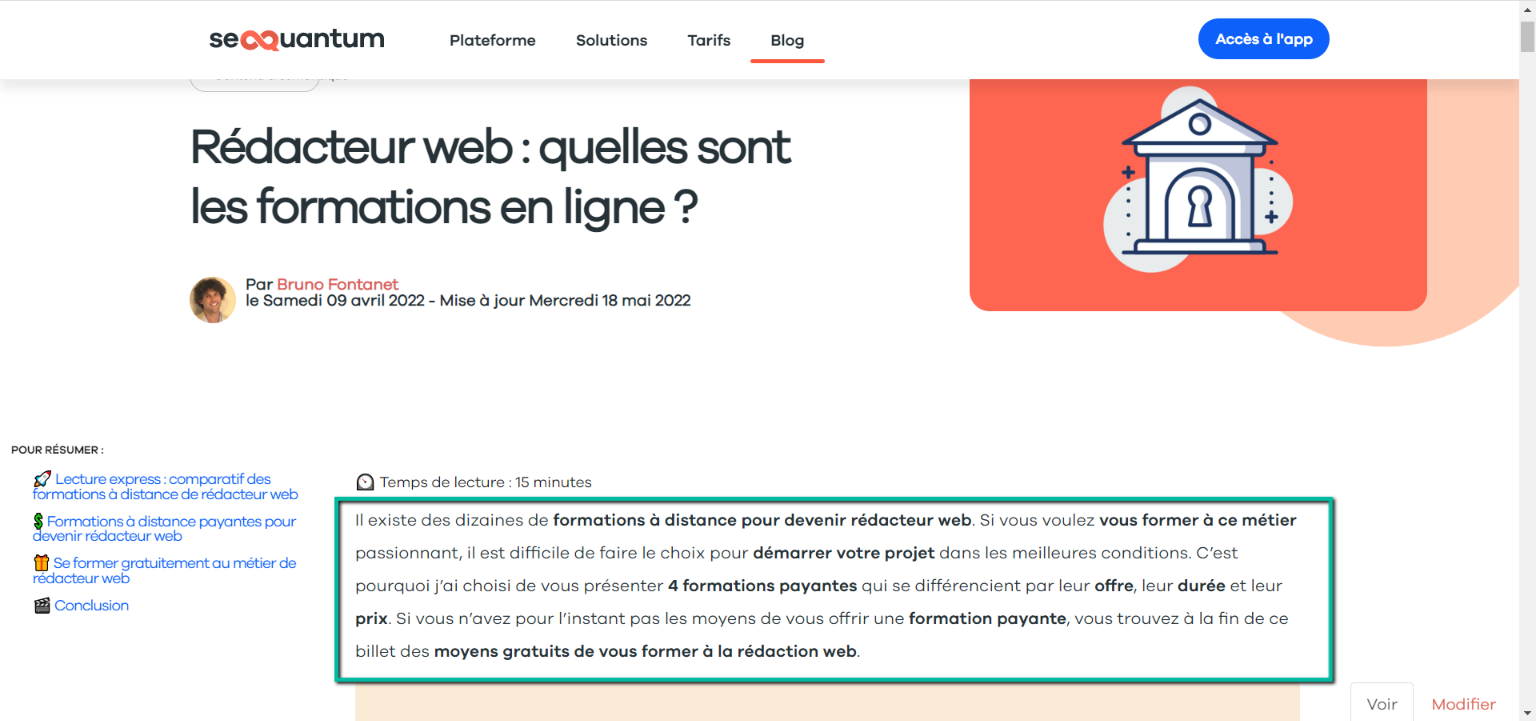
You only have a few seconds to captivate your visitor and make them want to continue reading! The introduction (also called lead) is crucial. In less than 100 words, you want to quickly detail the problem and propose an applicable solution. To do this, think of the 5 Ws:
- Who: who?
- What: what?
- When: when?
- Where: where?
- Why: why?
To optimize this hot zone, you work on semantics and try to include as many lexical variations as possible. Of course, your main query should also be included. This part of your text is so important that it is considered that the first 100 words are particularly taken into account by Google's algorithms.
🥈 The subtitles (tags: H2, H3, etc.)
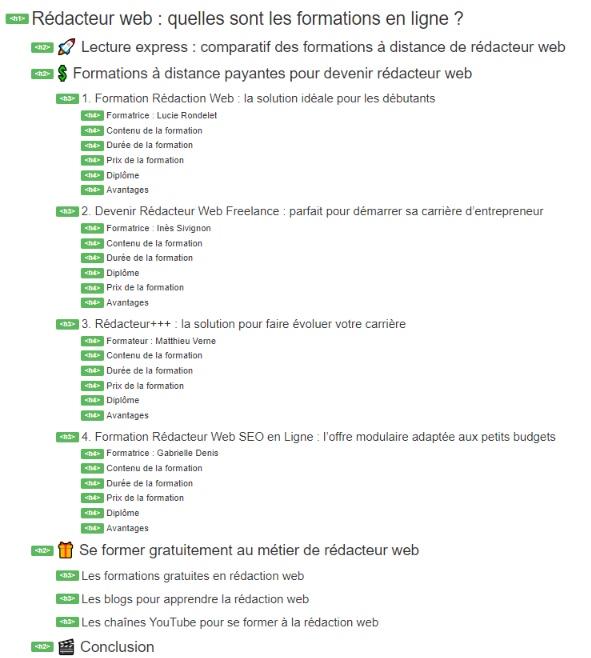
To facilitate reading in an "F" pattern, your subtitles are of great importance. This allows your reader to quickly find their way and find what they need without spending too much time. Based on this need of the user, indexing algorithms give "weight" to the words present in your subtitles.
In addition, some of your subtitles may be included in the SERP. This is especially the case in the "other questions asked" section. Therefore, adding your main keyword or a variant is important for your SEO. Moreover, googlebots appreciate clean HTML markup. This means that you must respect the hierarchy of titles and not use a solitary Hn tag (except for the H1, which must be unique!).
Example of a healthy HTML structure:
- H1
- H2
- H3
- H3
- H4
- H4
- H2
- H3
- H3
- H3
- H2
However, prioritize the user experience first, and then consider search engines. If your subtitle is more relevant without a keyword, don't try to add it at all costs. This way, you meet the needs of the user and don't over-optimize your content.
🤝 The conclusion
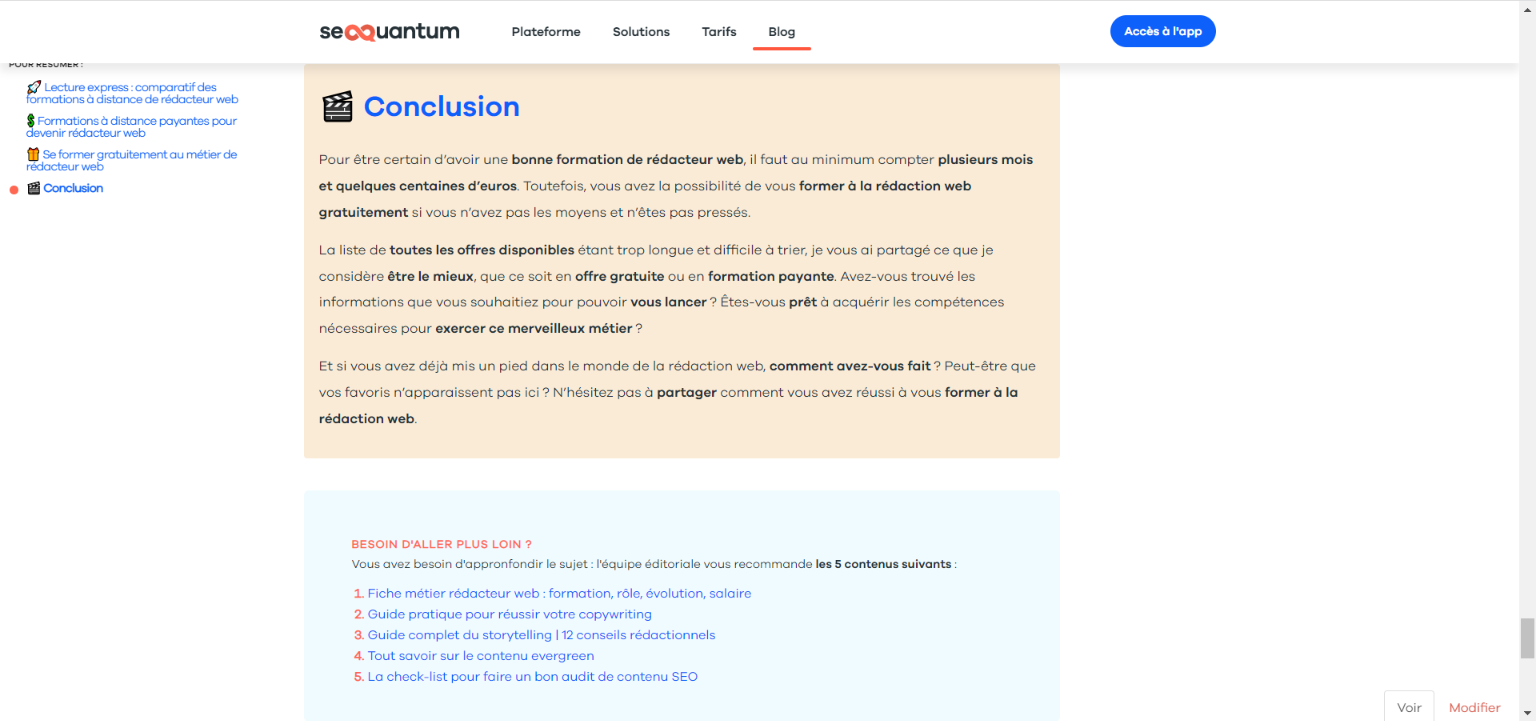
This area does not necessarily have a direct influence on your Google ranking. However, it is an important part of web writing because it is the last impression you leave on your visitor. Just like in real life, the first impression (introduction) and the last impression (conclusion) are essential for your interlocutor.
The conclusion is also an excellent way to reduce your bounce rate (visiting a page without any further actions on the site). By making a call to action (CTA) and offering additional resources, you increase your chances of retaining your traffic and leading it to conversion.
👉 The bold words (strong or b tags)
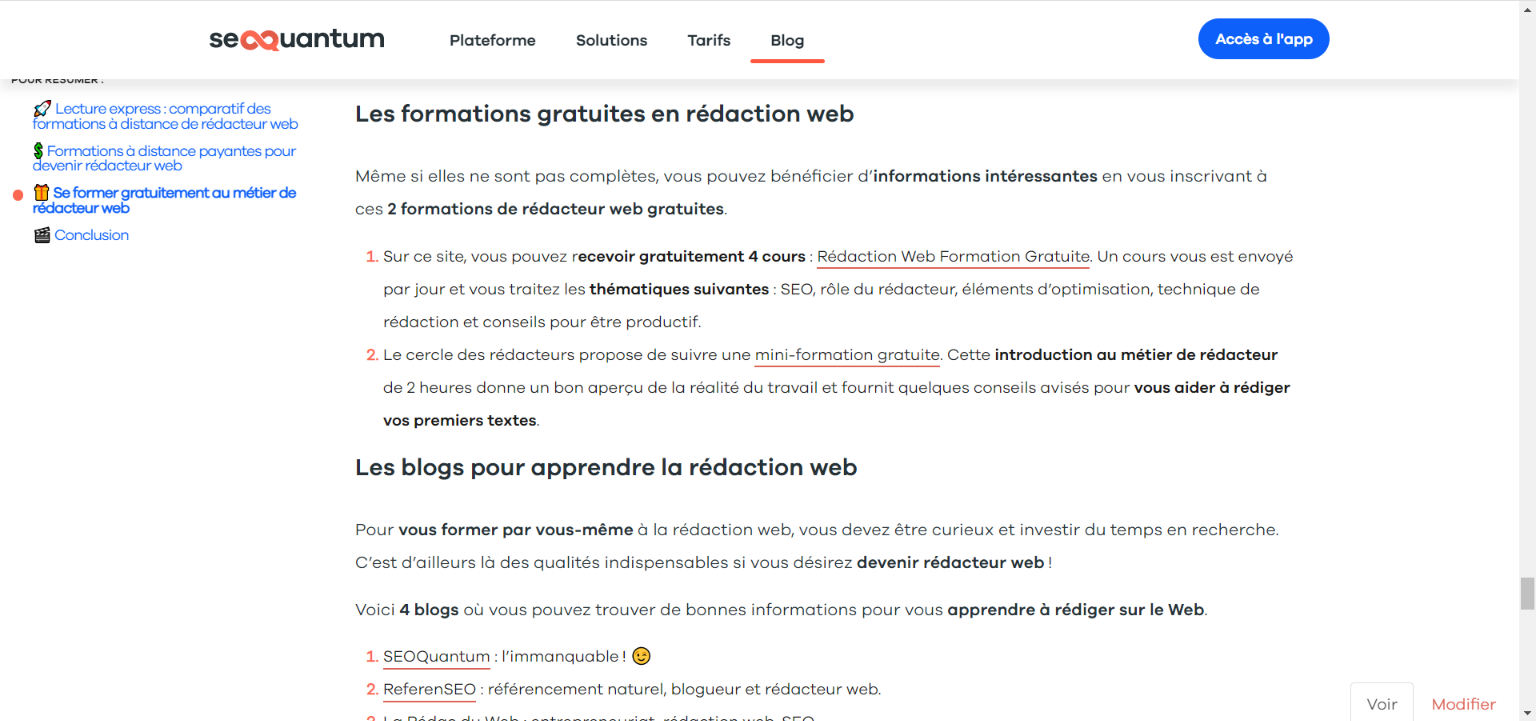
These elements facilitate diagonal reading and allow the reader to easily navigate the text. To check if the content is worth reading or to quickly skim it, bold words are an extremely effective means.
Do you want to check if you are meeting the user's needs? Just reread your article by looking only at the subtitles and bold words. If you have understood its meaning, the problems, and the solutions, then you have correctly written your web page.
The strong (or >b>) tag is also recognized by search engine algorithms. Thus, the highlighted words have a greater influence than others. However, your priority remains your reader. Do not always bold your keyword just to please Google. Indeed, it will likely notice and, as a result, is more likely to penalize you than to favor you.
👀 The bulleted lists (ul tag) or numbered lists (li tag)
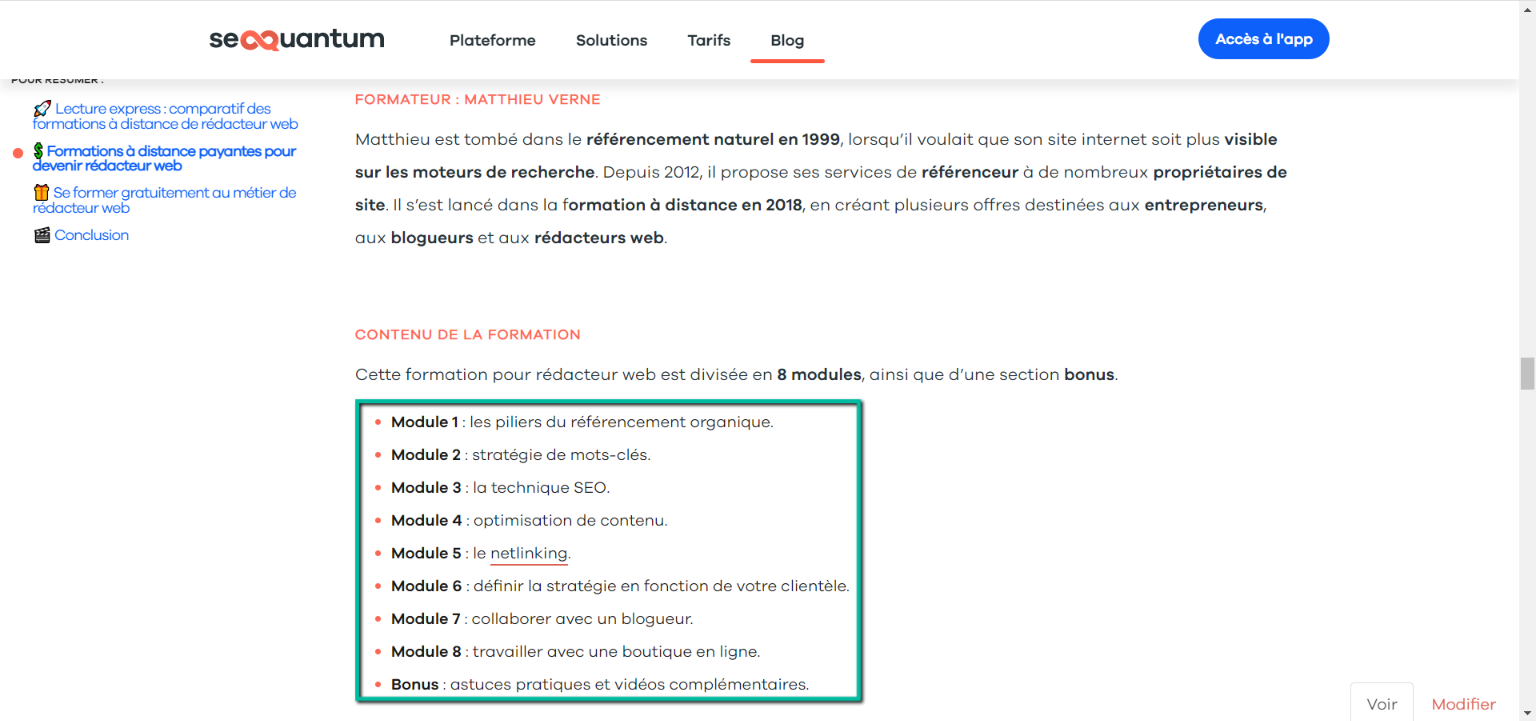
This is another excellent method to make reading more enjoyable and improve the quick understanding of your web page content. Thanks to lists, your reader gets a condensed version of useful information or a detailed methodology.
This is probably why Google appreciates this approach, which can sometimes be rewarded with a position zero (first result on the SERP with a content summary). So take advantage of these lists (tags
or - ) to provide an interesting summary for your reader, while increasing your chances of being highlighted by search engines.## 🔗 Internal links
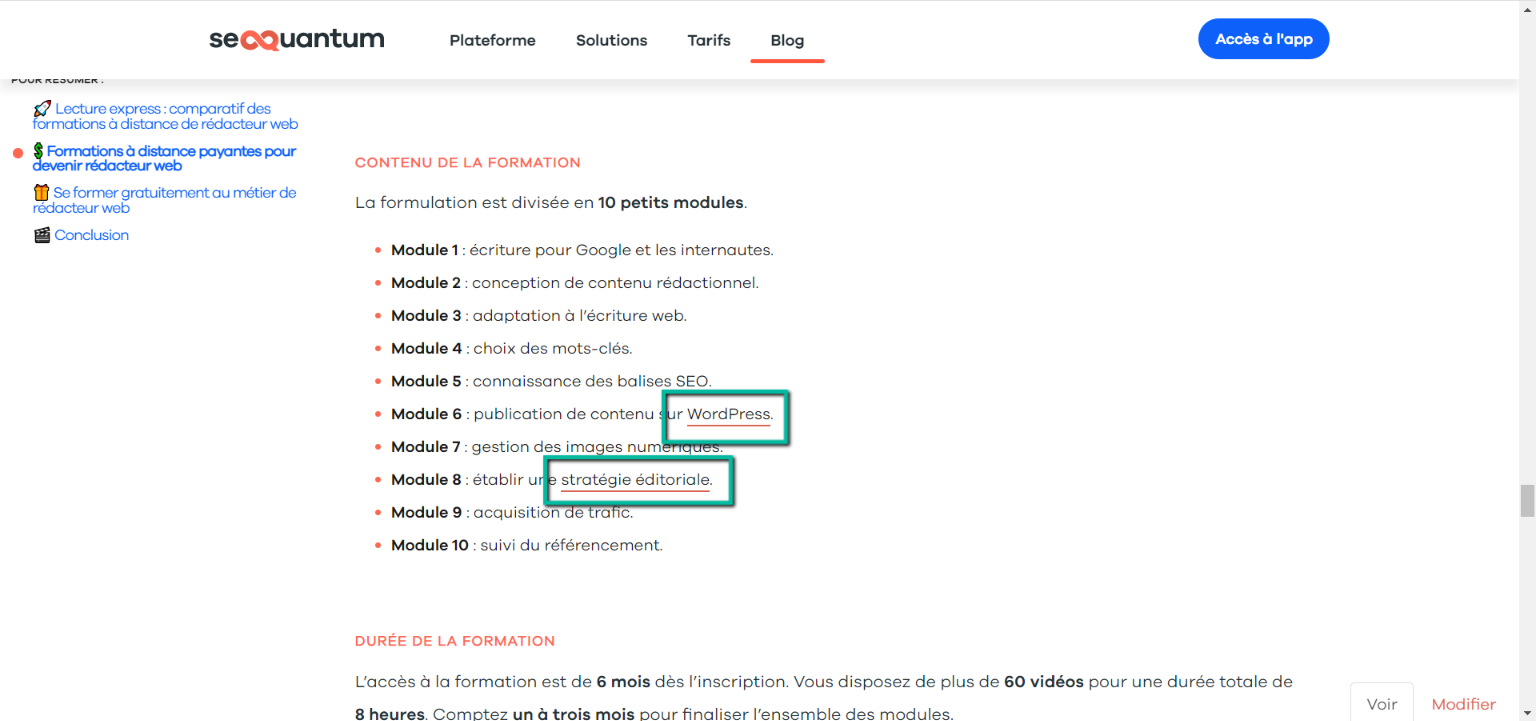
Internal links allow your visitor to access additional information that may be useful to them. As a result, you should place them whenever you feel it is necessary. Moreover, internal linking is absolutely essential for SEO.
Indeed, it helps to reduce the bounce rate and allows indexing robots to explore your site more efficiently. In addition, you transfer link juice (page power) between each of your pages. To learn how to optimize your link anchors, I invite you to read this other article: "Link anchors in SEO: 5 mistakes to avoid".
🖼 Image alt attributes
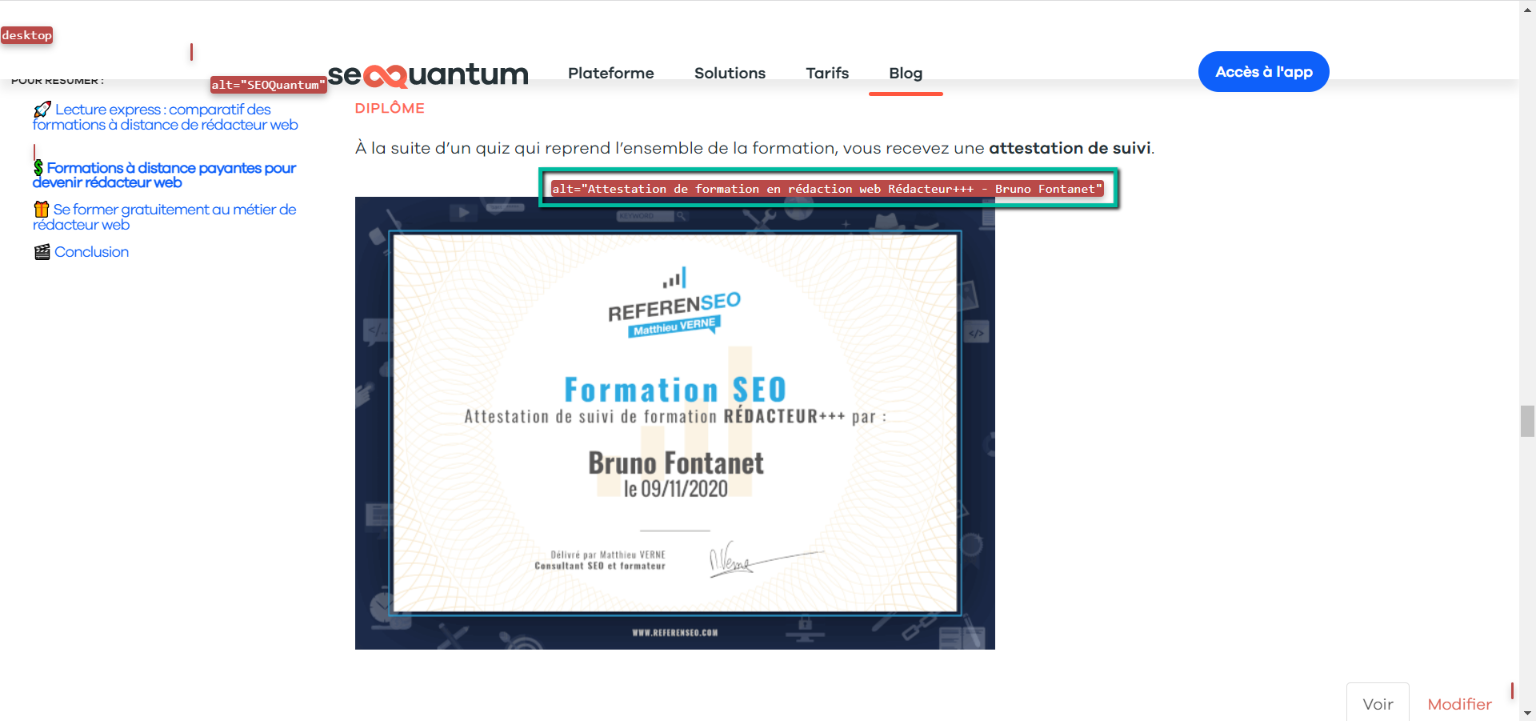
Although this text is not directly visible on the web page, it is indeed a hot zone not to be neglected. Indeed, the "alt" attribute is a brief description of your image content. By detailing this content, you allow search engines to know the substance of your illustration. As a result, you have a better chance of finding it in the results of "Google Images"!
In addition, this attribute improves the user experience for visually impaired users. Indeed, during a voice reading of content, this short text is read aloud. Thus, a precise description is very useful and will enhance the comfort of some of your readers.
💞 Metadata
Metadata is the information displayed directly on the search engine results page. It allows the user to choose which link to click on to obtain the information they need.
The title tag (h tag)

In 2021, Google has taken the habit of rewriting the titles displayed in the SERP (h tag). This phenomenon has caused an uproar in the SEO world and is now known as "Titlegate". Although the exact percentages are not known, it is estimated that 77% of titles displayed in the SERP have been modified, with 75% using the title of the page.
However, writing a different meta title (h tag) from the
title remains a good way to provide additional information to Google. Therefore, I recommend that you propose a semantic variant of your keyword or another way to present your content in your Google title (less than 60 characters). Indeed, even if it is not displayed, it can slightly improve your SEO.### The meta description

Strictly speaking, the meta description does not have a direct influence on the ranking of your page. However, it is an important area for the Googler to favor your page over another. To achieve this, it must provide additional information to your title and offer a solution.
If you have written a good meta description (unique and coherent in 160 characters), you will see a high click-through rate for your page. And a good CTR means improved SEO! So even if no importance has been given to the choice of words, your SEO will be indirectly influenced by your results.
💻 The URL
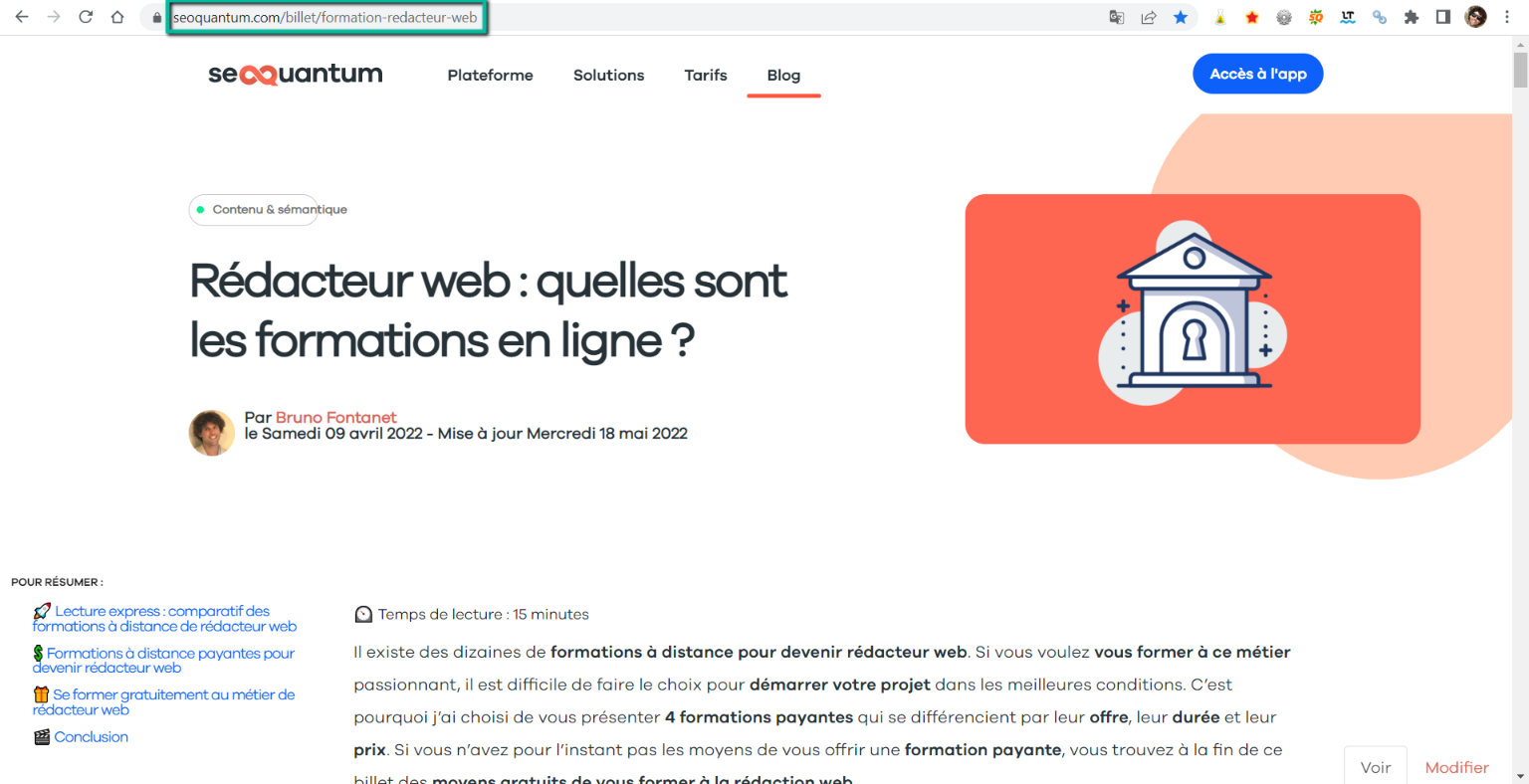
The URL has little importance for the average user, except to locate themselves within the website. However, the URL can be optimized for SEO! Indeed, each word has a certain power. By reducing their number, you can highlight your keyword. Here are some tips based on this fact:
- remove empty words (the, of, and, etc.);
- delete special characters (accents, &, %, etc.);
- separate each word with a hyphen rather than an underscore (underscore).
Warning: do not change your URLs once your page is indexed, as this will have more negative effects on your SEO than benefits! So keep this little tip in mind to optimize this element for your future publications.
Take the time to optimize each of these parts when writing your SEO content. However, focusing only on these 11 hot zones will not make your pages' SEO skyrocket! Indeed, for these actions to be effective, you must also:
- write quality content;
- refine the semantics of your texts;
- think about thematic clusters;
- fine-tune technical factors (on and off-page);
- improve the popularity of your site.
Now it's your turn! Review the last content published on your site and check if each of its sections has been properly optimized. If not, update your content (except for URLs!) for practice. Once you get used to it, these elements will naturally fall into place.
Need to go further?
If you need to delve deeper into the topic, the editorial team recommends the following 5 contents:
